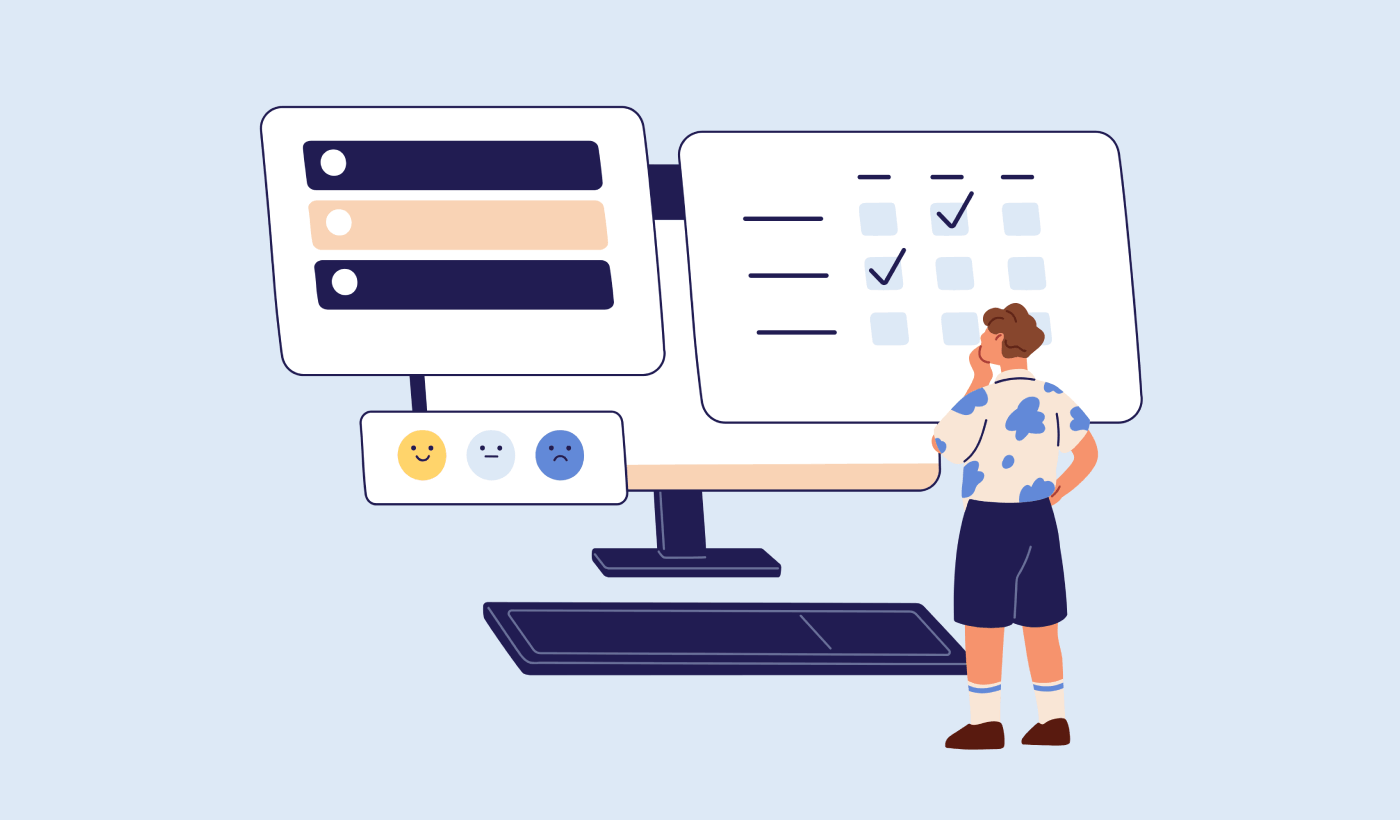Are you trying to find the perfect customer satisfaction survey examples and templates for your business?
Understanding customer satisfaction is key to refining your products and services. Knowing how happy your customers are can drive your business forward.
Surveys are an excellent way to measure customer satisfaction. By crafting the right questions, you can gather actionable insights to enhance your offerings and exceed customer expectations.
In this article, we’ll dive into various types of customer satisfaction survey questions and provide templates you can start using immediately. Plus, we’ll showcase real-world survey examples from successful companies and share best practices to ensure you get the most valuable feedback from your customers.
Ready to boost your business with effective customer surveys? Let’s get started!
Send Customer Satisfaction Surveys With Push Notifications!
Push notifications are a super effective, low-cost marketing tool to help you grow your repeat traffic, engagement, and sales on autopilot.
Why You Need Customer Satisfaction Survey Examples
Customer satisfaction surveys are your gateway to valuable insights about your customers’ needs and expectations. By implementing these surveys, you can pinpoint areas for improvement, segment your audience based on their responses, and more.
Here are a few reasons to use customer satisfaction surveys:
- Measure Satisfaction with Ease: Using rating scales and tracking key metrics, businesses can clearly see how well they’re meeting customer expectations. This approach allows you to set specific goals and strive for continuous improvement.
- Valuable Feedback for Continuous Improvement: Customer satisfaction surveys provide feedback that’s crucial for refining your business. From the moment a customer interacts with your brand to the point they become loyal advocates, these insights help create a positive experience.
- Track Progress Over Time: By regularly conducting customer satisfaction surveys, you can track changes in customer sentiment over time. Comparing scores from different periods helps you see if your efforts to enhance the customer experience are paying off.
- Actionable Insights: The feedback you gather from these surveys guides actionable improvements. Analyzing this data enables informed decisions about product enhancements, service improvements, and overall customer experience strategies.
- Easy Implementation: You can create an NPS survey form in WordPress using a simple forms plugin and get started in 10 minutes or less.
- Align Business Goals with Customer Expectations: Remember, customer satisfaction surveys help align your business goals with customer expectations, leading to higher satisfaction and loyalty.
And using customer satisfaction survey examples helps you get started super fast. You don’t need to hire a designer or a developer to start collecting customer satisfaction scores. Just use examples that are proven to work and get started.
Customer Satisfaction Survey Formats
When it comes to ensuring customer success and satisfaction, three main customer experience surveys are essential:
- Net Promoter Score (NPS) Survey: Measures customer loyalty to your brand by asking how likely they are to recommend you to others.
- Customer Effort Score (CES) Survey: Gauges how easy it is for customers to complete an action or interact with your business.
- Customer Satisfaction (CSAT) Survey: Assesses how happy customers are with your product/service, their overall experience, or any specific aspect of your business.
Customer surveys aren’t just for measuring satisfaction—they can also be used for market research, examining competitors, exploring new product features, and more. But for now, let’s zero in on customer satisfaction survey questions.
- NPS Survey Questions: Ideal for understanding overall customer loyalty.
- Example: “How likely are you to recommend us to a friend or colleague?”
- CES Survey Questions: Perfect for identifying friction points in customer interactions.
- Example: “How easy was it to navigate our website?”
- CSAT Survey Questions: Focus on specific aspects of customer satisfaction.
- Example: “How satisfied are you with our customer service?”
How to Collect Customer Feedback
The best way to start collecting customer feedback is to use a WordPress plugin that already has customer satisfaction survey examples built into it. I recommend using UserFeedback.
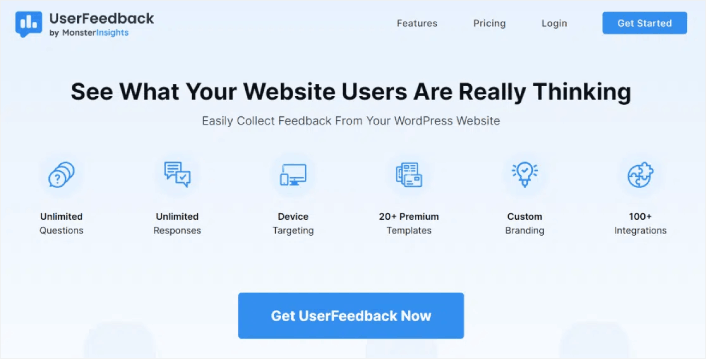
UserFeedback is the best WordPress plugin for launching customer surveys on your site. Use its short popup surveys to find out what your visitors really think.
The plugin comes with a ton of awesome online survey templates, and it’s super beginner-friendly. Plus, you can use our customer satisfaction survey examples as a guide for your own custom surveys.
The best part? It seamlessly integrates with MonsterInsights to track your form submissions and deliver reports inside your WordPress dashboard.
Get started with UserFeedback now!
Pro Tip: Looking to add extensive surveys and other form templates for your WordPress site? Check out WPForms, the best survey form builder for WordPress sites. You can even get started with our guide on how to create an NPS survey form in WordPress.
Best Customer Satisfaction Survey Examples
Now that you know why and how you can collect customer feedback, let’s take a look at some customer satisfaction survey examples.
#1. Star Rating Questions
Measuring Customer Satisfaction with Star Ratings
Using a star rating question is a popular and effective way to measure overall satisfaction. It gives you quantifiable data in a format that customers are familiar with and comfortable using.
To calculate your CSAT score, simply divide the number of satisfied customers (those who rated 4 or 5 stars) by the total number of respondents. This method provides a clear percentage that reflects customer satisfaction levels.
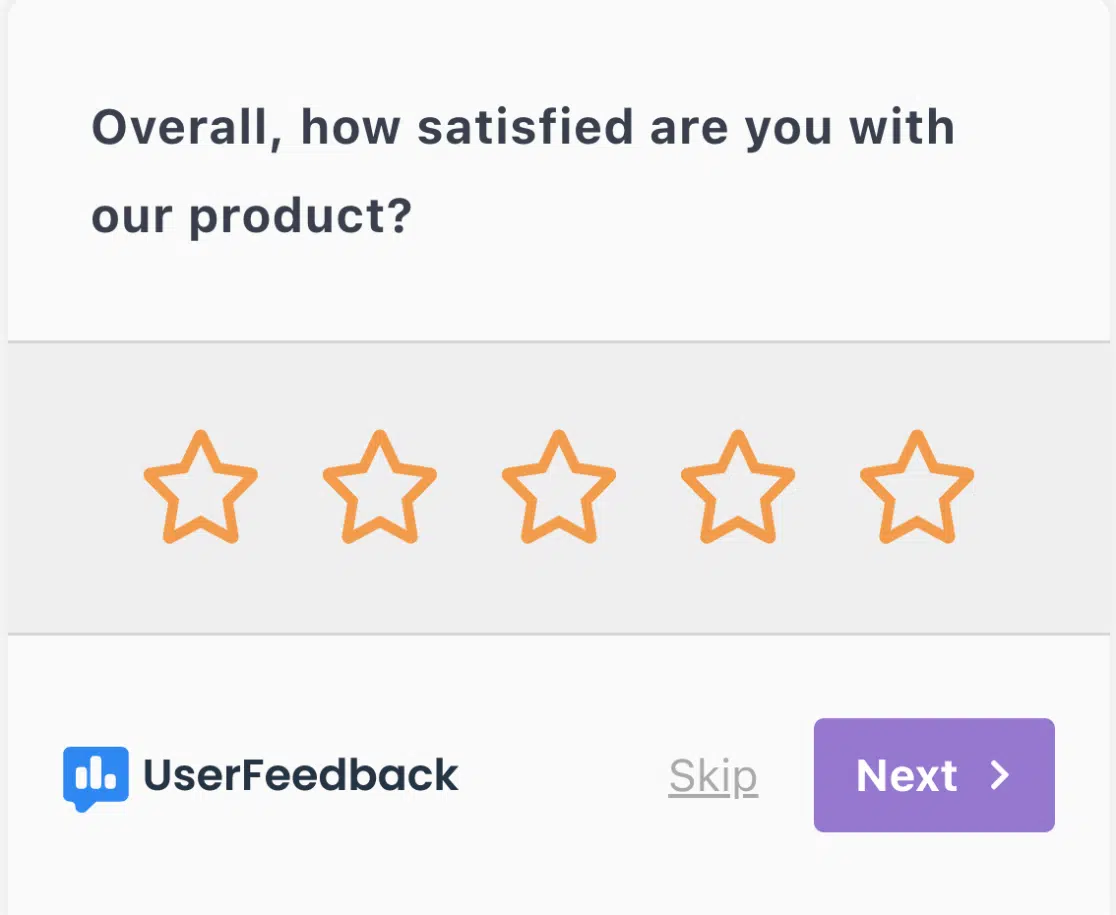
While star rating questions are a great starting point for determining customer satisfaction levels, they don’t always provide the full picture.
Isolated experiences can influence customers’ answers, and the star rating alone won’t uncover these nuances. Additionally, some customers may avoid choosing extreme ratings, even if that reflects their true feelings.
#2. Standard Likert Scale Questions
A Likert scale survey question is frequently deployed for crafting Net Promoter Score surveys (NPS), yet it serves as a versatile tool for gauging customer satisfaction as well.
Resembling a star rating, it furnishes quantifiable data conducive to computing a customer satisfaction score.
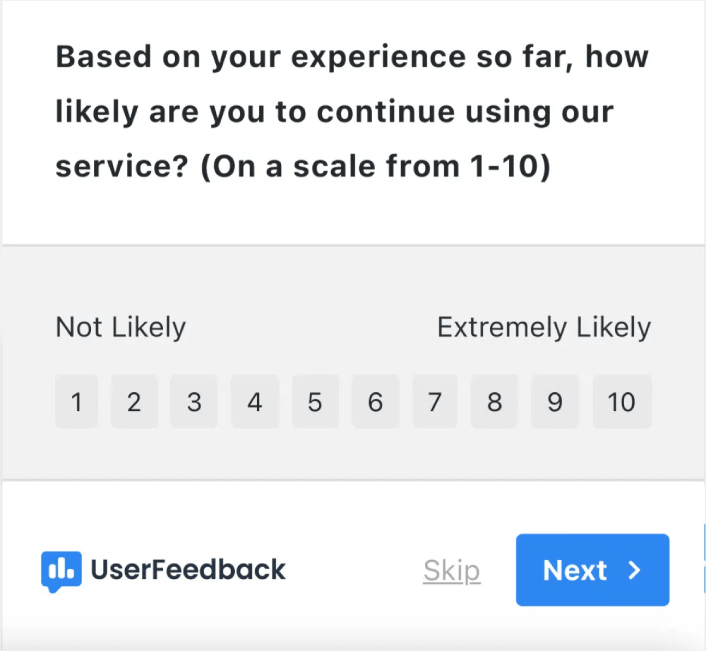
Employing this question format accommodates a broader spectrum of sentiments, potentially alleviating customer hesitation in opting for extremes. Moreover, it enhances the precision in identifying even minor declines in satisfaction levels.
#3. Binary Likert Scale Questions
Another alternative is a binary Likert scale, akin to the aforementioned question types. However, it omits neutral rating choices, thereby indicating whether the customer is satisfied or dissatisfied.
Despite the narrowed range, it retains utility and expedites the identification of overall customer sentiments.
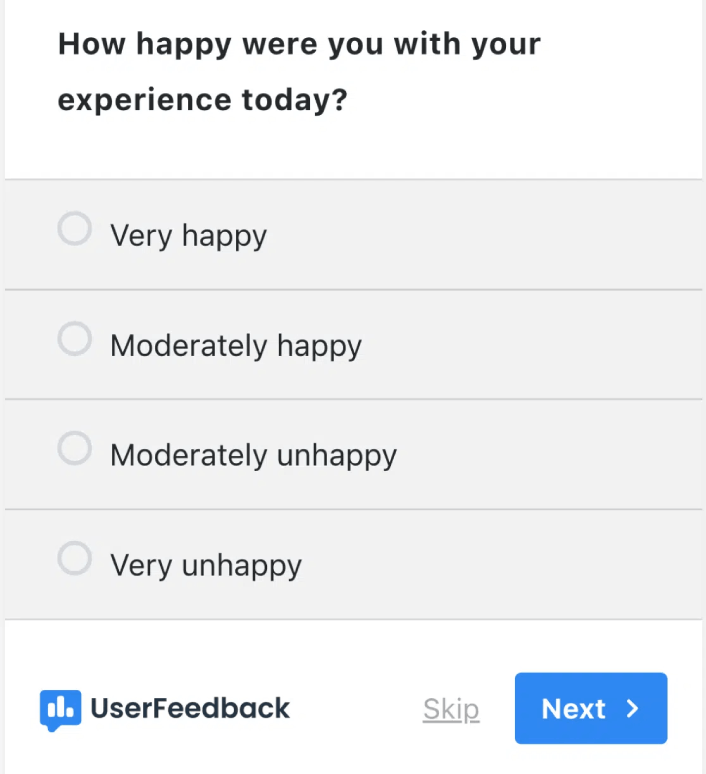
Once more, this question facilitates the acquisition of quantifiable data, yet it lacks the ability to provide context for why customers have reached a particular satisfaction level.
#4. Yes / No Questions
Another method to obtain binary responses is through a straightforward yes/no question. The advantage lies in its speed and simplicity, making it more probable to achieve a higher response rate from customers.
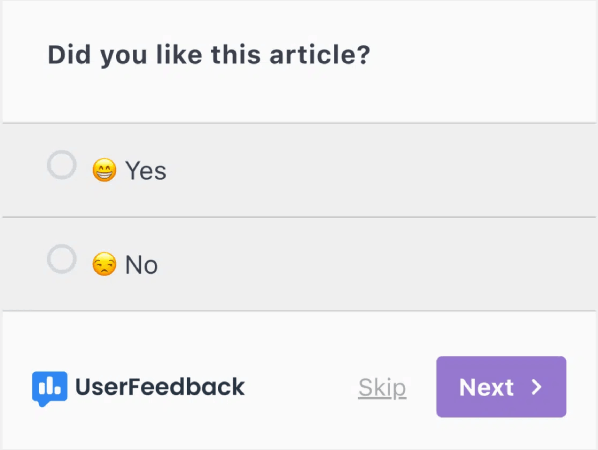
However, the drawback remains: this question fails to provide context and does not offer insights into the spectrum of customer satisfaction. Nevertheless, it serves as an efficient method to gauge overall customer sentiment.
Moreover, it proves especially beneficial for maximizing response rates, particularly when optimizing highly specific elements like individual blog posts or item pricing.
#5. Multiple-Choice Questions
While this question type tends to be more leading, it can still yield valuable customer insights regarding the most successful aspects of your business and reveal emerging trends.
You may pose inquiries about what your customers appreciate most or, conversely, inquire about their least favored aspects to pinpoint pain points and areas for improvement.
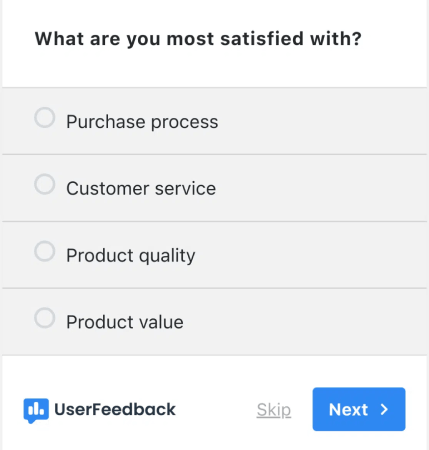
Pro Tip: If you’re using UserFeedback for your surveys, you can use Conditional Logic to determine what question shows next, depending on how the first was answered.
For example, if you asked a yes / no question first, the next question could be multiple choice with yes respondents being asked, “What were you most satisfied with?” and no respondents being asked, “What were you least satisfied with?”
#6. Open Ended Questions
Open-ended questions are the real gems in surveys. While they may not generate as many responses, the quality of the feedback received can outweigh quantity by a mile.
Customers have the opportunity to express their thoughts in their own words, offering invaluable insights into what would enhance their satisfaction and how your business can improve. Additionally, these responses furnish context for your Customer Satisfaction (CSAT) scores.
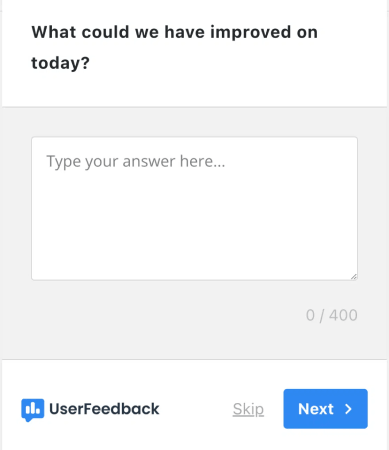
While open-ended questions offer invaluable insights, they lack quantifiable data. Thus, it’s advisable to complement them with other metric-focused questions to attain a comprehensive understanding of customer feedback.
#7. Checkbox Questions
Though leaning towards a leading nature, this question type can still unveil valuable insights into the most successful facets of your business and emerging trends.
You can inquire about what your customers appreciate most or, conversely, ask about their least favored aspects to identify pain points and areas for improvement.
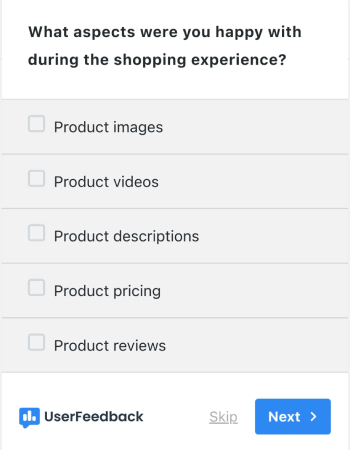
Offering a multiple-choice question with numerous options can overwhelm customers, leading them to hastily select the first option they see or even abandon the survey altogether. Using checkboxes simplifies the decision-making process for customers, enabling them to indicate their preferences for multiple consecutive items with ease.
How to Promote Your Customer Satisfaction Survey Examples
By now, you have a bunch of customer satisfaction survey examples. Next, you should set up form abandonment tracking to reduce your form abandonment rates. After that, all that’s left is promoting your surveys. A simple way to do that is to start using push notifications. Sending push notifications is a great way to generate repeat traffic for your site.
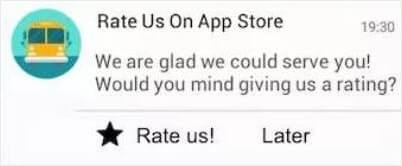
Check out this article if you’d like to get product reviews for your eCommerce store. If that’s something you’re interested in, you should check out these articles as well:
- Push Notification Cost: Is It Really Free? (Pricing Analysis)
- How to Get More Traffic to Your WordPress Blog (9 Easy Ways)
- How to Boost Your Web Push Notification Opt-In Rate (7 Ways)
- How to Add a Web Notifications WordPress Plugin to Your Site
We recommend using PushEngage to send your push notifications. PushEngage is the #1 push notification software in the world. So, if you haven’t already, get started with PushEngage today.
